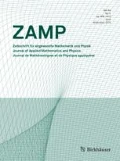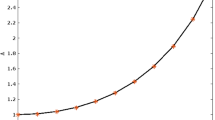Summary
The paper begins with a review of the essential points ofLanczos's orthogonalization procedure, which is of great importance for the determination of the eigenvalues of a real, but otherwise general matrix. Then several properties useful for numerical computation are proved:
If the degree of the reduced characteristic polynomial of the matrix ism, then it is possible to choose trial vectorsx, y such that the iteration may be continued for exactlym steps. At that point the process must stop because the iterated vectorsx m+1,y m+1 vanish (theorem 1).
If all the eigenvalues are real, then the co-diagonal elementsβ i [see equation (12)] can be made arbitrarily small by proper choice of the trial vectorsx, y (theorem 5), which considerably simplifies the evaluation of the eigenvalues and eigenvectors. Should, in addition, all theβ i still be positive (see theorem 4), then bounds for the eigenvalues may readily be given (theorem 3). Further remarks are made concerning matrices with complex eigenvalues.
Finally it is shown that by starting from a certain one-parameter family of trial vectors (11), the diagonal and co-diagonal elementsα(t),β(t) are solutions of a system of differential equations (25).
Similar content being viewed by others
Literaturverzeichnis
C. Lanczos,An Iteration Method for the Solution of the Eigenvalue Problem of Linear Differential and Integral Operators, Proceedings of a Second Symposium on Large Scale Digital Computing Machinery (Ann. Comput. Labor.26) (Harvard University Press, Cambridge, Mass., 1951), S. 164–206. — Siehe auch: J. Res. nat. Bur. Standards45, 255–282 (1950).
E. Stiefel,Über einige Methoden der Relaxationsrechnung (vgl. insbesondere § 5), ZAMP3, 1–33 (1952).
M. R. Hestenes undE. Stiefel,The Method of Conjugate Gradients for Solving Linear Systems, wird im J. nat. Bur. Standards erscheinen.
M. R. Hestenes undW. Karush,A Method of Gradients for the Calculation of Characteristic Roots and Vectors of a Real Symmetric Matrix, J. Res. nat. Bur. Standards47, 45–61 (1951).
J. H. M. Wedderburn,Lectures on Matrices, Amer. math. Soc., Colloquium Publications, Bd. 17.
G. Blanch,On the Computation of Mathieu Functions, J. Math. Phys.25, 1–20 (1946).
J. B. Rosser, C. Lanczos, M. R. Hestenes undW. Karush,Separation of Close Eigenvalues of a Real Symmetric Matrix, J. Res. nat. Bur. Standards47, 291–297 (1951).
L. Collatz,Numerische Behandlung von Differentialgleichungen (Springer, Berlin 1951 [Grundlehren der mathematischen Wissenschaften, Bd. 60]).
G. Kowalewski,Einführung in die Determinantentheorie (Veit, Leipzig 1909).
D. H. Weinstein,Modified Ritz Method, Proc. nat. Acad. Sci. USA.20, 529–534 (1934).
H. Wielandt,Ein Einschliessungssatz für charakteristische Wurzeln normaler Matrizen, Arch. Math.1, 348–352 (1948).
Author information
Authors and Affiliations
Rights and permissions
About this article
Cite this article
Rutishauser, H. Beiträge zur Kenntnis des Biorthogonalisierungs-Algorithmus von Lanczos. Z. Angew. Math. Phys. 4, 35–56 (1953). https://doi.org/10.1007/BF02075304
Received:
Published:
Issue Date:
DOI: https://doi.org/10.1007/BF02075304




